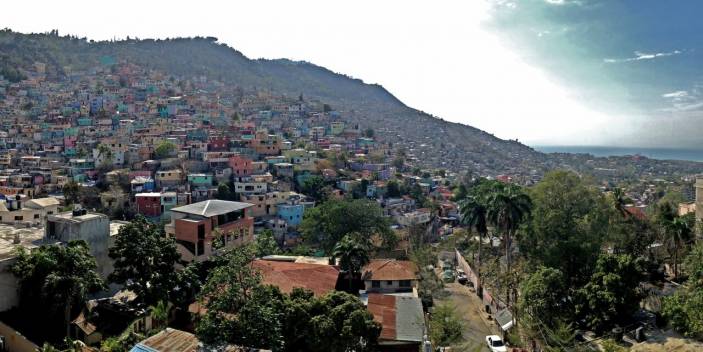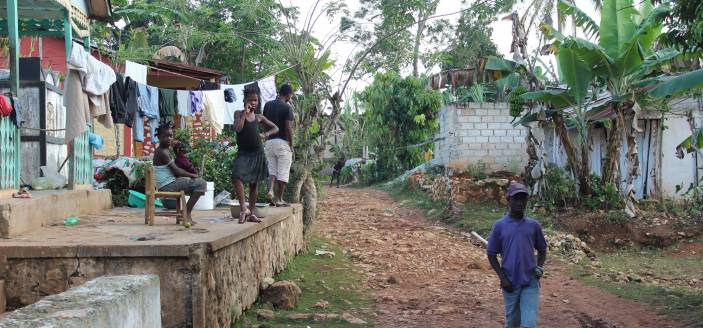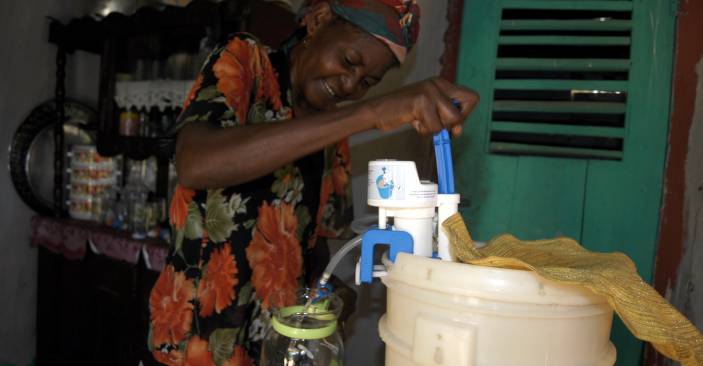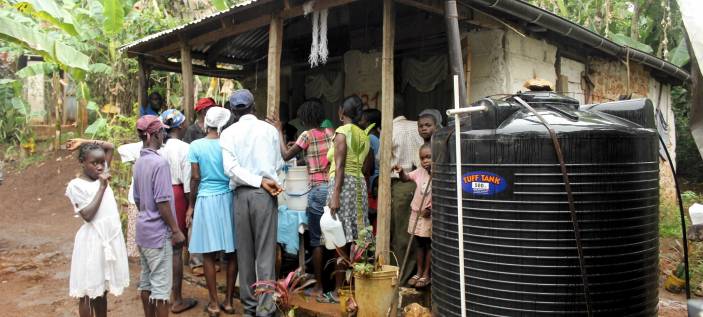In the southern highlands of Haiti, a programme that started as a test to obtain information about training in the use of a new type of water filter has been taken over by local people. During World Water Week, we tell the the extraordinary story of how, when given the opportunity, recipients of humanitarian relief can work among themselves to massively amplify the benefit of aid.
From poor to poorer
Dealing with the western hemisphere’s deadliest earthquake in recorded history, followed three years later by the Atlantic’s second most damaging hurricane, would have been a big enough challenge for even the wealthiest of nations.

Yet even before the magnitude-7 earthquake struck 25km west of Haiti’s capital Port-au-Prince on 12 January 2010, the country was by no means wealthy – ranked 22nd poorest in the world with respect to GDP per capita in 2009.
Such was the scale of the devastation in the country that, despite over US$13 billion of investment and humanitarian aid since 2010, Haiti climbed two places to 20th in 2014.
The challenge of cholera
HelpAge International, with funding from the Department for International Development (DFID), embarked upon a programme to provide 100 cyclone and earthquake resistant homes to households headed by older people. The programme focused on the District of Fond Jean Noel in the Marigot Commune, a remote community lying in the mountainous region south of the capital.

By March 2013 the programme had been completed. Yet a series of lethal cholera outbreaks had shown that there was another threat that was every bit as dangerous as earthquakes and typhoons: a lack of safe water.
Haitians suffer one of the lowest levels of access to an improved water source, ranking 179th out of 194 countries. People have to resort to taking water from heavily polluted rivers and streams used for bathing and as toilets.
The consequences are as clear as they are dire. In July this year, Haiti’s Ministry of Public Health and Population revealed there have been 745,588 reported cases of cholera and 8,972 deaths. Safe water is critical to keeping this epidemic under control.
Harvesting rainwater
Responding to the outbreak, HelpAge constructed 100 rainwater collection systems to complement the houses already built.
The systems helped reduce dependence on polluted water sources and reduced water collection times by up to 75%, but they were not available to the majority of the community. Meanwhile, completely uncontaminated water could not be guaranteed due to the exposed nature of the roofs from which the water was collected.
In order to provide a wide-reaching, effective solution for the whole community, all water, regardless of its source, would have to be filtered.
Various options were explored for filtering water, but these either proved too expensive or impractical.
The HelpAge and GrifAid® solution
HelpAge therefore embarked upon a field trial of a new kind of water filter that, while proven successful in other parts of the world, had yet to be used in Haiti.
The GrifAid Family® Aquafilter provides up to 90 litres per hour of safe drinking water. All bacteria are removed, including those which cause cholera. The filters require no chemicals or electricity and need no spare parts. With almost no maintenance, they last a minimum of five years.

Funding from DFID enabled a trial period with filters deployed to the 100 households with rainwater harvesters with an additional 500 filters distributed to selected families.
The trial was a great success. HelpAge and GrifAid® were thrilled. The overwhelmingly positive feedback received during the course of the survey would ultimately go on to help improve the filter’s design and inform how it could be introduced to other communities.
But that was not the most exciting part.
Elders take delivery into their own hands
Shared experience and wisdom suggests that, more often than not, aid recipients are reluctant to share. This hesitance is often motivated by fears that scarce and valuable resources might either be stolen or damaged, and of conflicts that might arise within the community as a consequence.
It is for this reason that aid agencies often avoid planning for the use of shared tools or equipment where possible.
It came as both a surprise and a reminder that receivers of aid should never be underestimated when, without any consultation or encouragement, community elders took matters into their own hands. They devised a network for sharing the filters through a system of supervised filtering stations known locally as Boukan.
Twenty-six Boukan have been established at central points in villages throughout the district. They give people who had not directly been given a filter the opportunity to ensure the water they gather is safe.

Four or five families come together to create each Boukan, sharing their filter for up to three hours per day. This allows for the delivery of up to 650 litres of safe, clean water daily from one Boukan, supporting the needs of more than 40 families.
Over a five-year period, each Boukan will produce over one million litres of safe water at a total cost of less than US$0.0002 per litre.
What began as a field trial to understand better how a community could be taught to use a new piece of equipment became a learning experience for the agencies involved. It is they who have been taught by the local community how to make the most of modest resources.
The next step?
What remains to be seen is if these lessons can be put to use in the rest of Haiti where the cholera epidemic, which had previously begun to shrink, is once more on the rise.
Find out more about the Boukan of Haiti YouTube or read the HelpAge field trial results.
